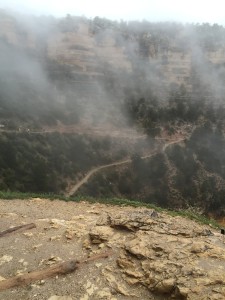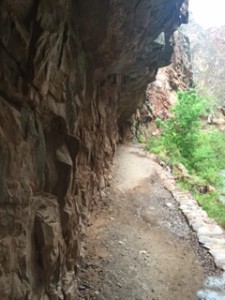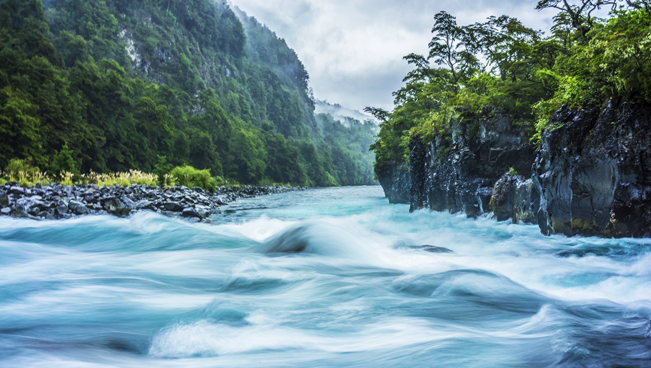by Mawer Investment Management, via The Art of Boring Blog
If ever there was an activity to experience vicariously, it’s got to be ultra-marathoning. I had the opportunity to do exactly that when I sat down, but did not run with Mawer CIO Jim Hall before and after he tackled the Grand Canyon “Rim 2 Rim 2 Rim” challenge.
In an effort to better understand why someone would deliberately run all the way down the Grand Canyon, run back up, and then back again for 15 solid hours through pain, rain and snow, I questioned both his sanity and his motivation. It turns out he’s quite sane, compellingly motivated, and happy to have survived it.
Starting early on April 30, Jim and three other friends tackled the R2R2R challenge—a one-day, 74km run with an over 20,000 foot “elevation change” through the Grand Canyon—to raise funds for the Calgary Silver Linings Foundation. The goal was to raise at least $90,000, the equivalent of $1 for every step, to build a residential treatment centre for Alberta’s growing eating disorder population. For Jim, whose daughter has been affected by a severe eating disorder, the run represented both a physical labour of love and a significant personal challenge.
Jim shares what motivates him to attempt challenges like this, how he prepares and executes, and ultimately, what he’s learned from the experience.
Pre-run questions (3 days before the Rim 2 Rim 2 Rim challenge)
JB: They call what you’re about to do “double-crossing” the Grand Canyon. Sounds pretty daunting. Are you sure you know what you’re getting yourself into?
JH: (laughs) I’ve heard that term, yeah. And yes, I do believe I’m ready for it. I’ve learned that over the course of a year there will be hundreds of people who do this. It’s not uncommon. It definitely puts you in rare company but not exclusive territory. It’s funny because I don’t consider myself a good runner. I’m slow, I have asthma, I don’t normally run these races, I don’t particularly enjoy them when I do, I’m terrible at it really. I sit at a desk 12 hours a day so I’m probably out of shape and my posture’s terrible. My story is not about an amazing ultramarathon runner who can do incredible superhuman things. No, I’m a fairly average person, who is a very mediocre runner.
There is no part of me saying I can do this and you can’t. I’m just a regular guy saying I can do this and so can you.
JB: What drives you to take on extreme challenges like these?
JH: I want to test myself. I want to test my limits physically and mentally and see where they take me. I don’t know what’s on the other side of all of this and I want to know. What’s it going to be like 7, 8, 9 hours into this run when everything hurts and I can barely move one foot in front of the other? I really want to know what I can do and what we can do as human beings. For me that’s a huge motivator. I find it fascinating to break through barriers to see what’s on the other side and I try to encourage others to do the same. Also, besides wanting to help the Foundation and wanting to discover these things about myself on my own journey, I really hope to inspire others to set their sights higher and to try something that they don’t think they can do but maybe… they can.
I think people should challenge themselves. To me, the definition of a challenge is any undertaking or task that you aren’t actually sure you can accomplish. If you’re 100% positive you can do something it’s not really a challenge, it’s just a job. Challenges definitely don’t have to be physical—they can take many forms in our personal or professional lives. If I can help other people get on a path where they can enjoy their own journey a little bit more, then that would be wonderful. These thoughts are very important to me and motivate me a lot.
JB: Obviously your primary motivation for doing this is to raise funds and awareness for the Calgary Silver Linings Foundation, but beyond this, how do you motivate your mind and body to tackle the run itself?
JH: It’s the training. 20-40% is physical and the rest of it is to train my mind to get to the point where I’m confident that I can at least have a decent shot at achieving my objective. When I start training, particularly for an event like this, a 30 or 40 km run is daunting. A hill, maybe a kilometer uphill, is really intimidating. But by the time I finish training, I look at those long runs and big hills with confidence, like, yeah, I can do this—it’s within my capability. I always remind myself that I’ve done this before, I’ve felt bad like this before and somehow I got through it, so I know I can do this now.
JB: Have you attempted anything like this before?
JH: I ran the Marathon des Sables (editorial note: ranked by the Discovery Channel as the toughest footrace on earth) four years ago in 2012. That was a 250 kilometer run across the Sahara Desert over seven days. That was definitely another big physical challenge similar to this one. It was basically a midlife crisis—a couple friends and I decided we would run the desert. What really cemented it was my buddy’s wife throwing down the gauntlet while we were sitting around the table talking about it. She said, “You guys couldn’t do that.” And from that moment it was on! I’d never run more than 10km in my life. I trained for that one for about a year.
JB: What did you learn from that experience that you can apply to this one?
JH: I learned many things. One is that as people we tend to set our goals too low. We’re capable of far more than we think, yet we never really put ourselves in a position where we actually have to test that. We do this for self-preservation, of course, because it’s typically not much fun or comfortable to push ourselves to absolute limits, whether that’s mental, physical or emotional. But when we have the opportunity to do so, we find out that we’re far stronger, far more capable of things than we ever imagined.
JB: How do you prepare and train for a run through the Grand Canyon?
JH: You break down a long term problem into smaller chunks along the way. You ask yourself, where do I need to be in 6 months’ time? Where do I need to be in 3 months, 1 month, this week, by the end of today? What do I need to do right now? Every day and every moment has purpose and builds towards something. It’s also important to be patient and committed. That’s the mental aspect. The amount of time needed to prepare is different for everybody, but your body and your mind will get there if you give them enough time.

The other thing you need is expert help. In the Marathon des Sables I had to ask a lot of questions and get a lot of help learning what happens to the body in extreme heat. What do I need to prepare for that? Training in Calgary’s climate didn’t help when I knew I had to run in 50 degrees Celsius across the desert. It’s the same thing with the Grand Canyon—what do I need to be able to do to withstand running up and down the canyon trail? I know how to run far on flat ground—it’s pretty simple, it goes left right, left right—but running down is, in my opinion, more difficult than going up because it’s so hard on your knees and quads. Going up is tough too, but going down is misery.
JB: Going down is misery…what other comparisons to investing did you recognize during this experience?
JH:(laughs) It’s very true. Just like investing, going down is not fun but you have to be prepared and have good advice to help you know what to expect and how to mitigate it. As with an investing portfolio you’ve got to expect downturns—in this case downhills—that are very difficult, painful times. If you’ve positioned yourself to withstand them, it doesn’t make it easy, but it makes it tolerable. And your mind doesn’t start to freak out about it. And I think that’s where the comparison to investing is a very close one—when the market’s going down it’s not fun, it’s the most unpleasant part of investing, you’re losing money. Running downhill I’m in pain and my knees want to pop out of the skin. But I knew what this was. I’ve seen it before, I’ve trained for it, I’ve gotten expert advice, I know I’m going to make it through this and that it will end. And that’s what helps get you through – planning that out and executing on a plan.
JB: Besides reaching your fundraising goal, how will you measure your success?
JH: Hey, I’ve already succeeded! I mean I still have to do it otherwise there wouldn’t be that challenge, but all that work that I’ve done over the last six months to get myself in a position so I can attempt this, that’s huge success. Because that takes an enormous amount of patience, dedication, support, training—all these things—so actually running it is the icing on the cake. The cake is the training that goes into it to get your mind ready. If I go and I don’t make it for whatever reason, I know it won’t be because I quit or I didn’t prepare enough. It will be because I had to stop.
That was one of my key learnings from the Marathon des Sables—the difference between quitting and stopping. Quitting is when you know you could keep going but you don’t because it’s hard and you just give up. Stopping is when you need to stop and can no longer go on. When you quit, you’ll always wonder, “what if”. When you stop, you know with certainty there was no more to give. You have no regrets. So if I have to stop, that’s fine. That won’t mean failure. If I quit, that would be failure.
JB: What do you expect to be your greatest challenge in making it from rim to rim to rim?
JH:Well, the thing I’ve trained the hardest for is running downhill – that second downhill from the North Rim is 22km—that is going to be tough. You’d think the final climb out would be the real one that you worry about, but at that point I’ll be able to see the finish, right? So I think that boost of excitement will carry me up the rest of the way. Going down that first 15k, then up 22k, turning around, then coming down 22k— that’s really going to hurt. So that’s one of the mental challenges I’ve worked on the most. I suppose the greatest worry I should have is that I slip and fall… Slip and fall off and go down a thousand feet – that could be deadly. Or twist an ankle, break a leg, a wrist – break something – doesn’t necessarily have to be deadly but it could be enough to cause me to stop. Which would really suck.
JB: You’re also not going alone, so the risk of injury to at least one of you obviously increases.
JH: Yeah, I’m going with three other people and something could happen to any one of them. And again, if something happens it’s over. You don’t keep going and leave someone at the side of the trail. So that would be a disappointment, but if that’s the case I’ll just run it in November. If someone gets injured we’ll deal with it.
At the same time, you’ve built in a lot of resilience by running with three other people. If you run solo you don’t have to worry about anyone else, but if something goes wrong you’re in big trouble. If you run with one other person, the chances are greater that one of the two of you could be injured, but you’ve also now got built in resilience. If you’ve got three people it’s even better because one person can stay with the injured person, another can go get help, so you really want to have at least three people… (laughs) I guess what I’m saying is that you really want to diversify. Just like investing, when you buy more companies, sure, each one is risky in itself, but the portfolio becomes less risky and more resilient to bad things happening if you’re diversified.
JB: When you’re running with other people is there a sense of team or is it essentially a solitary endeavour?
JH: Over the course of the entire day, I probably won’t run near my teammates for more than half an hour total. You basically do your own thing at your own pace, occasionally you catch up to each other and you make sure everyone’s okay. But more than that it’s the emotional, spiritual part where you know that your friends are with you. And that’s very true of the training as well. The actual run itself is the smallest part. The biggest part is the training and that’s hard to get through alone.
That’s another one of my biggest learnings—the power of the people around you and their support. You really start to notice that you’ve got a lot of people pulling for you, a lot of people assisting in different ways, whether that’s with the physical training or the support of family and friends. There are always people out there that have got your back and are willing to help. Most of the time we just don’t ask.
JB: Plus, in terms of risk/reward, part of the reward in doing this with others is being able to share this experience.
JH: Absolutely.
JB: So, just as that mental preparation fortifies you for potential adversity, it also enables you to build up your resilience, like another muscle?
JH:Exactly. When all is said and done you have to prepare your mind for all the stuff you didn’t prepare for. It’s also important to trust yourself and to believe that any setback or obstacle is not going to derail you entirely. For example, a little over a month ago I severely bruised my heel. I couldn’t train, I couldn’t even walk. It’s ironic, because this happened to me before, three weeks before my des Sables marathon. I actually fractured my fibula that time. I certainly didn’t expect that to happen. So at the time, I figured, okay, I have to think about how I’m going to accomplish this task anyway, even though I’ve got this new burden I didn’t expect.
I have a whole speech around this called If it weren’t for this, If it weren’t for that. So if it weren’t for the fact that I just bruised my heel I’d have a great run, if it weren’t for the fact it’s raining and I’m starting when its one degree Celsius … if it weren’t for that I’d have a great run down the Grand Canyon and back. You always get some damned thing in your way. That’s life, what are you going to do with that? Nobody goes into a race at 100% and nobody’s life has perfect conditions. You’ve got to somehow find a way to accept that and not let it destroy your whole day, your whole week, or your whole life.
Post-run questions (5 days after the Rim 2 Rim 2 Rim challenge)
JB: First of all, congratulations. You did it!
JH: Thank you very much.
JB: So, how was it?
JH: It was very much what I expected. I expected it to be hard and it was. I expected it to be a long day and it was. It took us about 15 hours in total. I expected there would be obstacles and challenges that would be difficult to overcome and there were. I expected I would find a way through them and I did. I knew going in that I needed to expect the unexpected. Sure enough, the unexpected hit. So nothing went according to plan – but that was the plan. That nothing would go according to plan.
JB: What were the surprises that didn’t go according to plan?
JH: (laughs) I was surprised that the last hour of the North Rim involved snow! It was a complete whiteout. The trail was covered and the sky was filled with big fluffy snowflakes. I thought there might be a few flakes here and there but this was like a December snowfall. At the top there was a good centimeter to two centimeters of snow accumulated on the ground. So that was worse than expected. Another surprise I didn’t expect was that the Grand Canyon was so staggeringly large.
JB: Oh, you’d never been there before?
JH: No, never. I’d just seen it on TV and in pictures. You cannot appreciate the scale until you’re there and see it up close. I’m not scared of heights but I was getting vertigo just standing close to the edge. It’s so far down. I was getting nervous, just from the sensation of falling off. Of course once you get on the trail you don’t have any of that. You see the trail is wide enough and it feels comfortable. But when I first got there and looked down from the rim… yikes. I was also surprised when my knees gave out in the first minute. I hadn’t gotten 200 metres and I discovered my knee hurt.
JB: That can’t be good.
JH: It wasn’t. Remember I’d had an injury about six weeks before the race, so that caused some issues and came back to haunt me on the day. I knew it would be bad on the downhill but it was worse than I expected. Within the first 10 minutes of the downhill I realized, uh oh, I’ve got all day to go here and it already hurts. So when I said you have to expect the unexpected – that was it. As a result of that heel injury I’d had a very hard time training to run downhill–I just couldn’t. That meant my knee joints were a bit weaker than they probably should’ve been, and also unbalanced, so I was always landing hard on my right side because my left side was painful. I was limping down during training and that’s what gave out— my right knee—so I had a bit of a tough time with that.
JB: At what point did the adrenaline wane and did it really start to suck?
JH: Well it comes and goes. You get these ups and downs throughout the day. Sometimes you feel like a million bucks, sometimes you feel like two cents. There was a moment climbing the North Rim where I was feeling a bit crappy and I knew I hadn’t eaten enough and I needed some calories. So I just sat down and had some energy chews and I was good.
JB: When we talked before the run you thought the hardest part would be the descent from the North Rim. Was it?
JH: Yes, it was. I got to the top of the far side and it was just snow and freezing cold and I had to turn around and come down, which I knew, for me, was probably going to be the hardest part. When I was standing at the top I couldn’t even straighten my leg out–it was that painful. I got down about 10 feet, took three steps down and was like, oh my god. Luckily, I’d brought my hiking poles, so I was able to use those to help out a bit. I got down about half a kilometer or so – I’d started off ahead of my partners because I knew I’d be very slow. They caught up to me in seconds and my running mate Drew asked, “How’s your knee?” I said it’s really bad. He asked if I wanted some Advil and I said, yeah, I better take some. He had some at the front of his backpack, but we were completely soaked at this point because we’d been running up in snow for the last 40 minutes and two hours before that we’d been in the rain. Our hands were also numb. So he’s trying to dig around in this tiny pocket for the Advil and there’s just no way you’re getting these things out cleanly. He pulls out his fleece glove-covered finger and hands me this clump of Advil soup/mush mixed with wool and pocket lint and he’s like, here you go. So I take it – that’s how bad it was that I was willing to take this, because at that point I just wanted anything that would help. I’m not sure how many I actually took in that clump but we started down again and about 15 minutes later they kicked in and the pain became manageable enough to get down to the bottom. That was what I expected to be the worst and it was.
JB: Can you describe your state of mind over the span of those 15 hours?
JH: This is going to sound weird, but, besides the temporary pain, it was one of the most relaxing times of my life. I think that’s one of the reasons why I like doing it. Because my life is very stressful and there are lots of things to worry about. I’ve got to run portfolios, I’ve got to run a business, I have a family, all this stuff – we all have stress in life. When you go out to do an activity like this there’s only one thing to think about and that’s moving forward. Just putting one foot in front of the other. For me, that’s the only time in my life that is completely stress free. Because I know for the next 12 to 15 hours I’m only expected to do one thing. No one’s going to email me, no one’s going to ask me about something. There may be a bit of stress that creeps in as I think about my knee hurting and how I’ve got a long way to go, but other than that it’s a release for me. It’s relieving to be able to spend a day, or seven days (in the Sahara), living a very simple life. There’s a lot to be said for that, and yes, this is an extreme example, but I find it’s so important to take time to get that simplicity. Life for us, in our society, is very busy, very complex, very loud, but time on the trail is peaceful and calming on the mind and I like that. While my physical body is slowly but surely breaking down, my brain is actually saying thank you, this is nice.
JB: What kinds of things do you think about while you’re running?
JH: I’m a real Zen runner –I don’t really think about anything, it’s really just left right, left right. At the same time we weren’t trying to set any speed records so I had time to stop on the trail, snap a picture, and really enjoy the scenery because it’s stunningly beautiful down there. I was grateful that I had the chance to stop, look around and really enjoy this wonderful place in nature that very few people get to see up close like we did. I remember thinking how great and how easy it was. Occasionally other thoughts creep in, but luckily, for me, they’re always positive thoughts. Obviously, I thought about my knee but more so I was thinking how lucky I was to be there with a friend who happened to have exactly what I needed and was somehow able to dig it out in the snow and cold and rain and share it with me, and isn’t that a great example of humanity and being able to rely on others, and doing things with partners, and being able to help each other out? That’s what I was thinking about.
JB: What was the highlight of the run for you?
JH: We were coming up the trail and we were running about two hours behind from where we thought we’d be. With about two kilometers to go when I’m coming up, just slogging away—it’s getting dark and I’m by myself—off in the distance, I see these two little specks of people. One of them has blond hair and an orange jacket which stood out against the background, the other was even smaller. I thought that could be my kids. I happened to be in one of the few places on the trail that had a really good echo, so when I yelled out the echo bounced around and she stopped and looked my way and, sure enough, it was my kids on the trail. I had expected to see them at the top but they had come down to meet me, so that was a real boost of energy for me. I thought, this is why I’m doing this, for people like my daughter, and I want to have these experiences and share them with my family, so it was a really emotional moment for me and really helped me get through the last 25 minutes to reach the end.
JB: What did you learn?
JH: Learnings… yes hundreds of things. Some I already knew, some I needed to be reminded of. I knew if you set your sights high you can achieve things. I relearned that. Even though I’m not particularly gifted, I can still do things like this because I have the ability to believe in myself to try and train. So preparation and belief – those are old learnings. With my friends on the run, my family being there, the support I had back home – all those things were just a reminder for me of how so many people want us to succeed and are willing to help if given the chance. I think we forget about it, especially in our day to day at work when we’ve got a job to do and most of that work is done at our desk by ourselves, between our own ears. Yet, what I’ve discovered is that, despite the fact that we spend the bulk of our time doing those things, that’s not actually where things happen. Things happen as part of a group and as part of a bigger entity, and I think that’s how we move forward.
JB: Did you ever doubt yourself or question your ability to finish?
JH: No. There was a moment in the Canyon when my friend Drew and I were soaked and we could see the top of the rim another 1000 vertical feet with sheer
cliffs all around, and he just looks at me and says, “This was pretty ambitious.” (Laughs) So there was that moment. There was a moment where I questioned whether I was going to get done before dark because of my knee. But I never felt I couldn’t finish the task.
JB: How did you break the run up into manageable chunks and, speaking of chunks, what did you eat for fuel over the course of the day?
JH: We stopped at least every half hour or 45 minutes—I’m guessing 30 times. In terms of what I ate…I had a homemade granola bar, a bag of macadamia nuts, two packets of energy chews, two Stinger waffles, two nut bars, a peanut butter sandwich…until the Pop Tart. (Jim’s eyes light up with a Pop Tart-eating grin). That Pop Tart was my ticket home, baby. I saved it the whole trip, I was like, I got this beauty, it’s pure sugar—it’s like the whip on the backstretch of the Kentucky Derby—you don’t bring out the whip too early or the horse will die. Then, when you see the finish line you whip like crazy! So I took out the Pop Tart whip with about 5k to go, all up hill, and then I didn’t eat again.
JB: The Pop Tart whip. That’s beautiful. Given that we often talk about the “so what” of things, what’s the “so what” you’ve drawn from this entire experience?
JH: It hasn’t gelled quite yet but I woke up in the middle of the night after the run—my body was sore so I couldn’t sleep well—and the phrase “I’m not alone” popped into my head. I’m not alone in this hotel room, my family’s here; I wasn’t alone on the run, I had a wonderful experience of seeing my family at the end; I had a wonderful experience of having the help of a good friend bail me out at a dark moment on the trail; and I had the experience of seeing so many people contribute to this cause and support me in doing it. We’re not alone, nobody’s alone. Also, be thankful for those people around you and don’t be afraid to ask for help. I didn’t do this run alone. In the training, preparation, the doing of it, I didn’t raise all this money myself– I’m not going to solve the problem of eating disorders by myself, I’m asking for help in all those things and so far I’ve gotten a lot of help, and that’s a wonderful feeling. It was actually one of the “so-whats” of the MDS too. Whereas I’d spent most of my life as a bit of a lone wolf, trying to stand alone, be independent, then finally realizing that, of course there’s a time and place for that, but there is also time to work with others.
JB: What’s next? Are you thinking about the 6630 Ultra up north?
JH: What’s that?
JB: Seriously? I thought for sure you’d know about it. It’s only a 566 kilometer run through the snow from the Arctic Circle to Tuktoyuktuk. Seems like the logical next step, no?
JH: (laughs) I don’t know about that. It seems like I’m on a four year schedule for the extreme physical challenges and then I’m good for a while. Even on Saturday I was saying to myself – never do this again. It hurts in the moment but then later it fades and you start thinking about doing something else. So I guess we’ll see. Ask me about it in 2020. In the meantime, I’ve started kickboxing. My next goal is to participate in a real kickboxing fight within the next two years and win.
JB: With discipline, the right attitude, and a single Pop Tart, it sounds like anything is possible. Good luck Jim and thanks for sharing this experience with us.
This post was originally published at Mawer Investment Management














